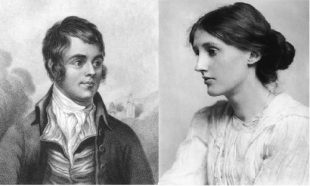Tak’ up ye pens all library lasses,
An’ dust aff a’ yer readin’ glasses
Get scribblin’ fur th’ deadline passes,
20th December.
We’ll haud the best o’ Burns/Woolf bashes
So do remember!
If you’re curious as to what an Ayrshire farmer and an upper-class pioneer of 20th century Modernism have in common, look no further. Herland’s latest incarnation, the much anticipated Burns Night/Woolf Supper is fast approaching, and we want you to submit a piece of writing inspired by Robbie and Ginny to perform at our evening of Romantic Modernism.
Born on the same day, 123 years apart, Robert Burns and Virginia Woolf were literary icons of different countries and very different eras. The event will certainly generate some interesting debates on the frames of reference of both writers, exploring the things that unite them and stirring up some contemporary literary creativity. Whether it’s in the form of an extended soliloquy, a slam poem, an epic ballad or something in between, we’d love you to share your work with us.

If you’re itching to carry out some lyrical experiments but aren’t sure where to start, here’s a bit of information on the literary styles of the two wordsmiths.
As exemplified in poems such as ‘To a Mouse’, Burns often employed the Standard Habbie, a unique form of stanza made up of 6 lines, with the rhyme scheme aaabab. As you can see below, the last two syllables of lines 1,2,3 and 5 rhyme with each other, as do lines 4 and 6.
Wee, sleekit, cow’rin, tim’rous beastie,
O, what a panic’s in thy breastie!
Thou need na start awa sae hasty,
Wi’ bickering brattle!
I wad be laith to rin an’ chase thee,
Wi’ murd’ring pattle!
The lines are given their characteristic Caledonian lilt with pairs of syllables known as iambs, in which the stress falls naturally on every second syllable (as in the word ‘shazam’, da DUM). In the longer lines 1, 2, 3 and 5, there are four pairs of these syllables, also known as iambic tetrameter:
— / — / — / — / — (da DUM da DUM da DUM da DUM da)
Wee, sleekit, cow‘rin, tim‘rous beastie
And lines 4 and 6 are in iambic dimeter, meaning that there are only two pairs of iambs:
— / — / — (da DUM da DUM da)
Wi’ bickering brattle!
What’s also rather interesting given the nature of our event, is Burns’ penchant for using a feminine rhyme at the end of each line,that is, a rhyme with two syllables, (beastie, breastie, hasty, chase thee etc.), perhaps something to bear in mind when writing your performance piece?
Of course, this is just one example of form that Burns used and there is no need to stick to the rules in your own work. Maybe you could invent your own stanza, or be a bit freer with the rhyme scheme, it’s up to you. If we’re talking about breaking all the rules, we couldn’t really ask for a better author than Virginia. Woolf is famous for her long paragraphs of ‘streams of consciousness’ in her fiction. Often foregoing form, coherent meaning or specific direction, she placed an emphasis on the chaos of the human condition through her tendency to slip between the points of view of various characters. Perhaps a musing monologue in Scots, or a narration on modern day feminism in Habbie form would fit our bill nicely? I’ve taken the liberty of coming up with a few titles to get the ball rolling:
Tae a Lighthoose
Mrs Ramsay, a captivating yet mature demolitions expert muses on the fragility of modern architecture as she gives the go ahead for the wanton destruction of the nest of an innocent lighthouse keeper.
A Brig’ A Doon of One’s Own
Drunken lout Tam o’ Shanter is confronted by a group of reasonable feminists who simply want to point out to him that literary opportunities afforded to female writers are often few and far between.
Mrs Galloway
A woman plans a hootenanny near Dumfries and ponders her life choices.
Well, you get the idea…
Email your entries to info@womenslibrary.org.uk with Burns/Woolf in the subject field before 20th December. Please include your full name, a contact number, and tell us whether or not you would be interested in performing on Friday 27th January should your work be selected. Happy writing!

Comments are closed.